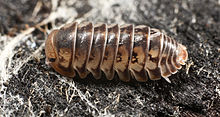Armadillidae
| Armadillidae | |
|---|---|

| |
| Venezillo parvus | |
| Scientific classification | |
| Domain: | Eukaryota |
| Kingdom: | Animalia |
| Phylum: | Arthropoda |
| Class: | Malacostraca |
| Order: | Isopoda |
| Suborder: | Oniscidea |
| Section: | Crinocheta |
| Family: | Armadillidae Brandt, 1831 |
| Type genus | |
| Armadillo Duméril, 1816
| |
| Diversity | |
| c. 80 genera, 700 species | |
| Synonyms | |
|
Cubaridae Brandt, 1833 | |



Armadillidae is a family of woodlice (Oniscidea; terrestrial crustaceans), comprising around 80 genera and 700 species. It is the largest family of Oniscidea, and one of the most species-rich families of the entire Isopoda.[1][2] Most of the armadillidae taxa are not monophyletic. Armadillids generally have a strongly convex body shape, with some rather shallowly convex.[3] Like members of the woodlice family Armadillidiidae, armadillids are capable of enrolling into a sphere (conglobation), and are commonly known as pill bugs.[4][5] Some species, however, have secondarily lost their conglobation ability. For example, a species exist in which the males lack the inner face of the coxal plates and are therefore unable to conglobate. [6] Armadillids differ from the Armadillidiidae in that the antennae are fully enclosed within the sphere.[7]
Species of Armadillidae occur in a variety of habitats including forests, savannas, and arid regions. Armadillids occur natively in the Afrotropics, Asia, Australia, the Neotropics, and the Mediterranean region of Europe.[8] A few poorly-known species occur in North America north of Mexico, and some are introduced.[9][10]
The family Armadillidae was erected by German naturalist Johann Friedrich von Brandt in 1831, although the earliest named genus now assigned to the family is Armadillo, described by French zoologist André Marie Constant Duméril in 1816. The German zoologist Karl Wilhelm Verhoeff described nearly one quarter of currently recognized genera (17).
Genera
[edit]Each genus listed below is followed by the author citation, the biologist(s) who first coined the genus, and the year of its publication.
- Acanthodillo Verhoeff, 1926
- Acanthoniscus Kinahan, 1859
- Aethiopodillo Verhoeff, 1942
- Akermania Collinge, 1919
- Anchicubaris Collinge, 1920
- Annobodillo Schmalfuss & Ferrara, 1983
- Anthrodillo Verhoeff, 1946
- Armadillo Duméril, 1816
- Aulacodillo Verhoeff, 1942
- Australiodillo Verhoeff, 1926
- Barnardillo Arcangeli, 1934
- Barrowdillo Dalens, 1993
- Bethalus Budde-Lund, 1909
- Buddelundia Michaelsen, 1912
- Calendillo Dalens, 1993
- Calmanesia Collinge, 1922
- Chelomadillo Herold, 1931
- Coronadillo Vandel, 1977
- Cosmeodillo Vandel, 1972
- Cristarmadillo Arcangeli, 1950
- Ctenorillo Verhoeff, 1942
- Cubaris Brandt, 1834
- Cubaroides Vandel, 1973
- Cuckoldillo Lewis, 1998
- Diploexochus Brandt, 1833
- Dryadillo Taiti, Ferrara & Kwon, 1992
- Echinodillo Jackson, 1935
- Emydodillo Verhoeff, 1926
- Ethelumoris Richardson, 1907
- Feadillo Schmalfuss & Ferrara, 1983
- Filippinodillo Schmalfuss, 1987
- Formosillo Verhoeff, 1928
- Gabunillo Schmalfuss & Ferrara, 1983
- Globarmadillo Richardson, 1910
- Hawaiodillo Verhoeff, 1926
- Hybodillo Herold, 1931
- Kimberleydillo Dalens, 1993
- Laureola Barnard, 1960
- Leucodillo Vandel, 1973
- Lobodillo Herold, 1931
- Merulana Budde-Lund, 1913
- Merulanella Verhoeff, 1926
- Mesodillo Verhoeff, 1926
- Myrmecodillo Arcangeli, 1934
- Nataldillo Verhoeff, 1942
- Neodillo Dalens, 1990
- Nesodillo Verhoeff, 1926
- Ochetodillo Verhoeff, 1926
- Orodillo Verhoeff, 1926
- Orthodillo Vandel, 1973
- Pachydillo Arcangeli, 1934
- Palaeoarmadillo George Poinar Jr, 2018
- Papuadillo Vandel, 1973
- Parakermania Vandel, 1973
- Paraxenodillo Schmalfuss & Ferrara, 1983
- Pericephalus Budde-Lund, 1909
- Polyacanthus Budde-Lund, 1909
- Pseudodiploexochus Arcangeli, 1934
- Pseudolaureola Kwon, Ferrara & Taiti, 1992
- Pseudolobodillo Schmalfuss & Ferrara, 1983
- Pyrgoniscus Kinahan, 1859
- Reductoniscus Kesselyak, 1930
- Rhodesillo Ferrara & Taiti, 1978
- Schismadillo Verhoeff, 1926
- Sinodillo Kwon & Taiti, 1993
- Sphaerillodillo Arcangeli, 1934
- Sphaerilloides Vandel, 1977
- Sphenodillo Lewis, 1998
- Spherillo Dana, 1853
- Stigmops Lillemets & Wilson, 2002
- Sumatrillo Herold, 1931
- Synarmadillo Dollfus, 1892
- Togarmadillo Schmalfuss & Ferrara, 1983
- Tongadillo Dalens, 1988
- Triadillo Vandel, 1973
- Tridentodillo Jackson, 1933
- Troglarmadillo Arcangeli, 1957
- Troglodillo Jackson, 1937
- Tuberillo Schultz, 1982
- Venezillo Verhoeff, 1928
References
[edit]- ^ Schotte, M. (2015). Schotte, M.; Boyko, C.B; Bruce, N.L.; Poore, G.C.B.; Taiti, S.; Wilson, G.D.F. (eds.). "Armadillidae Brandt, 1831". World Marine, Freshwater and Terrestrial Isopod Crustaceans database. Retrieved 2015-05-21.
- ^ Ahyong, S.T.; Lowry, J.K.; Alonso, M.; Bamber. R.N.; Boxshall. G.A.; Castro, P.; Gerken, S.; Karaman, G.S.; Goy, J.W.; Jones, D.S.; Meland, K.; Rogers, D.C. & Svavarsson, J. (2011). "Subphylum Crustacea Brünnich, 1772". In Zhang, Z.-Q. (ed.). Animal biodiversity: An outline of higher-level classification and survey of taxonomic richness. Zootaxa. Magnolia Press. pp. 165–191. ISBN 9781869778491.
- ^ Gary C. B. Poore (2002). Crustacea: Malacostraca : Syncardia, Peracardia : Isopoda, Tanaidacea, Mictacea, Thermosbaenacea, Spelaeogriphacea. Csiro Publishing. pp. 286–302. ISBN 978-0-643-06901-5.
- ^ Hale, Herbert H. (1929). The Crustaceans of South Australia (PDF).
- ^ Charles Leonard Hogue (1993). Latin American Insects and Entomology. University of California Press. pp. 110–. ISBN 978-0-520-07849-9.
- ^ Schmidt, Christian (2008-04-22). "Contribution to the phylogenetic system of the Crinocheta (Crustacea, Isopoda). Part 2. (Oniscoidea to Armadillidiidae)". Zoosystematics and Evolution. 79 (1): 3–179. doi:10.1002/mmnz.20030790102.
- ^ Little, Colin (1983). The Colonisation of Land: Origins and Adaptations of Terrestrial Animals. Cambridge University Press. p. 80. ISBN 978-0-521-25218-8.
- ^ Taiti, Stefano; Paoli, Pasquino; Ferrara, Franco (1998). "Morphology, biogeography, and ecology of the family Armadillidae (Crustacea, Oniscidea)". Israel Journal of Zoology. 44 (3–4): 291–301. doi:10.1080/00212210.1998.10688952 (inactive 1 November 2024).
{{cite journal}}: CS1 maint: DOI inactive as of November 2024 (link) - ^ Wright, Jonathan C. "Southern California Oniscidea". Pomona College. Retrieved 2015-05-21.
- ^ Muchmore, William B. (1990). "Terrestrial Isopoda". In Dindal, Daniel L. (ed.). Soil Biology Guide. Chichester: John Wiley. pp. 805–817. ISBN 978-0471045519.
External links
[edit] Media related to Armadillidae at Wikimedia Commons
Media related to Armadillidae at Wikimedia Commons Data related to Armadillidae at Wikispecies
Data related to Armadillidae at Wikispecies
